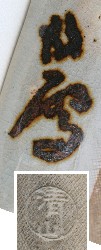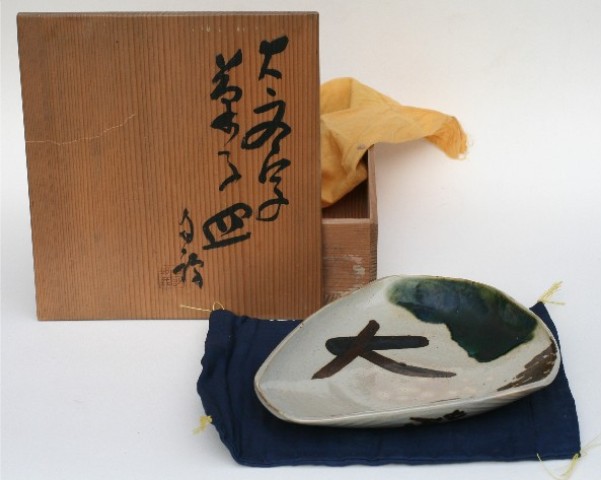Nihonga
Kashizara, cake dish - DaimonjiSigned: Kansetsu
Seals: Seizan
Technique: Kyoyaki, Oribe style. Grey gohonde glaze and green copper glaze iron oxide overglaze painting. 19,8 x 22,7 x 3,8
Box: signed by both painter and potter
Condition: fine
Daimonji refers to the Daimonji Okuribi festival, which starts at 8pm on the 16th of August. Halfway up the mountains which surround the city of Kyoto pine branches are laid out in the shape of the three strokes of the character dai (‘large’). The strokes have a length of 80m, 160m and 120m respectively. Setting the branches on fire marks the beginning the Obon festivities in Kyoto. It is said that the tradition originated when the monk Kobo-Daishi, praying for an end to a plague epidemic, lit up the character for the first time. The bonfire can be seen from every part of the city.
Kansetsu was born in Kobe from a family of artistic background. His father was a painter, poet and scholar of Chinese classics, his mother an amateur painter and his grandfather a famous haiku poet. Because of his father’s reputation Kansetsu's parental home was a meeting point for artists and scholars from China as well as from Japan. After receiving his first training from his father, Kansetsu studied Shijô painting with Kataoka Kôkô (dates unknown). In 1903 he continued his studies with Takeuchi Seihô, who had just returned from Europe. They never got along really well and finally broke in 1923. From 1913 onwards Kansetsu travelled to China almost every year from 1913. He went to Europe in 1921 and 1927. These trips and his education made him a true bunjin, in the literati tradition.
Kansetsu was a member of the Art Comity of the Imperial household and Imperial Art Academy, and a constant exhibiter at the Bunten.
Reference:
Kyoto 1957
Kyoto 1977
Conant pp. 293-294 (# 99, 144)
Berry & Morioka ‘99 pp. 224-29 (# 64-65)
Berry & Morioka ‘08 pp. 261-63 (# 13)
Roberts p. 41
Price: SOLD

